Braided Easter Bread: A Golden, Sweet, and Festive Masterpiece 🥖✨🐣
1. Introduction
Braided Easter Bread is more than just a recipe – it’s a cherished tradition that brings families together during the spring season. This beautifully decorated sweet bread, with its golden crust and soft, pillowy interior, has been gracing Easter tables for generations. The delicate citrus notes combined with warm vanilla create an irresistible aroma that fills your kitchen with holiday cheer. Whether you’re continuing a family tradition or starting a new one, this foolproof recipe will guide you through creating a showstopping centerpiece for your Easter breakfast or brunch spread.
What makes this bread so special is its versatility. It works equally well as a sweet treat for your holiday dessert table or as the star of your morning meal. The braided design symbolizes unity and celebration, while the colorful decorations add that perfect festive touch. Even if you’re new to bread-making, our detailed instructions will help you create bakery-quality results that will impress everyone at your table.
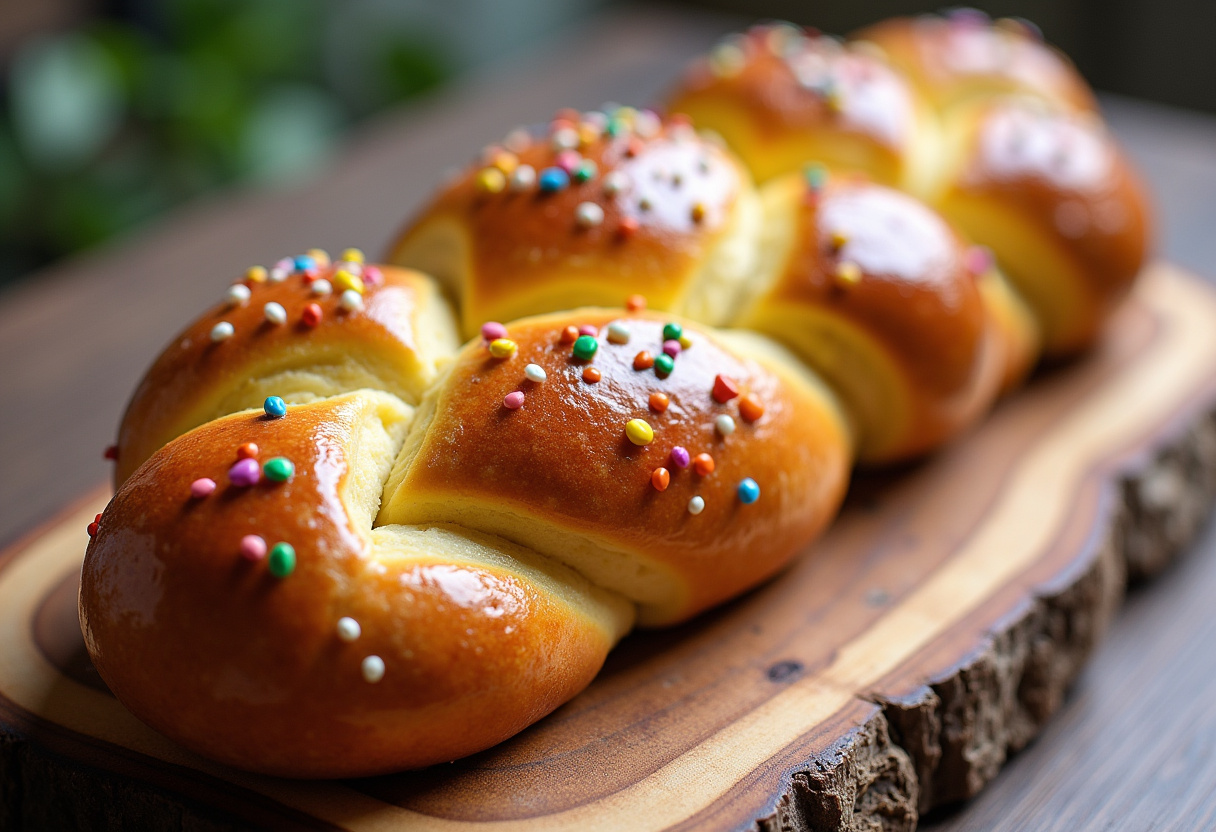
2. Ingredients
Gathering quality ingredients is the first step to baking success. For this traditional Braided Easter Bread, you’ll need:
- 4 cups all-purpose flour – The foundation of your dough. For best results, fluff the flour before measuring.
- 1/2 cup granulated sugar – Provides the perfect level of sweetness without overpowering.
- 1 packet (2 1/4 tsp) active dry yeast – The leavening agent that gives the bread its airy texture.
- 1/2 tsp salt – Enhances all the flavors in the bread.
- 1/2 cup warm milk (110°F) – Whole milk works best for richness, but any milk will do.
- 1/4 cup unsalted butter, melted – Adds moisture and tender crumb.
- 2 large eggs – At room temperature for best incorporation.
- 1 tsp vanilla extract – Pure vanilla gives the best flavor.
- Zest of 1 orange or lemon (optional) – Bright citrus notes complement the sweetness.
- 1 egg yolk (for egg wash) – Creates that beautiful golden sheen.
- Colored sprinkles or pearl sugar (for decoration) – Traditional Easter colors make it festive.
If you’re looking for other holiday baking inspiration, check out our Potato Chip Toffee recipe for another crowd-pleasing treat.
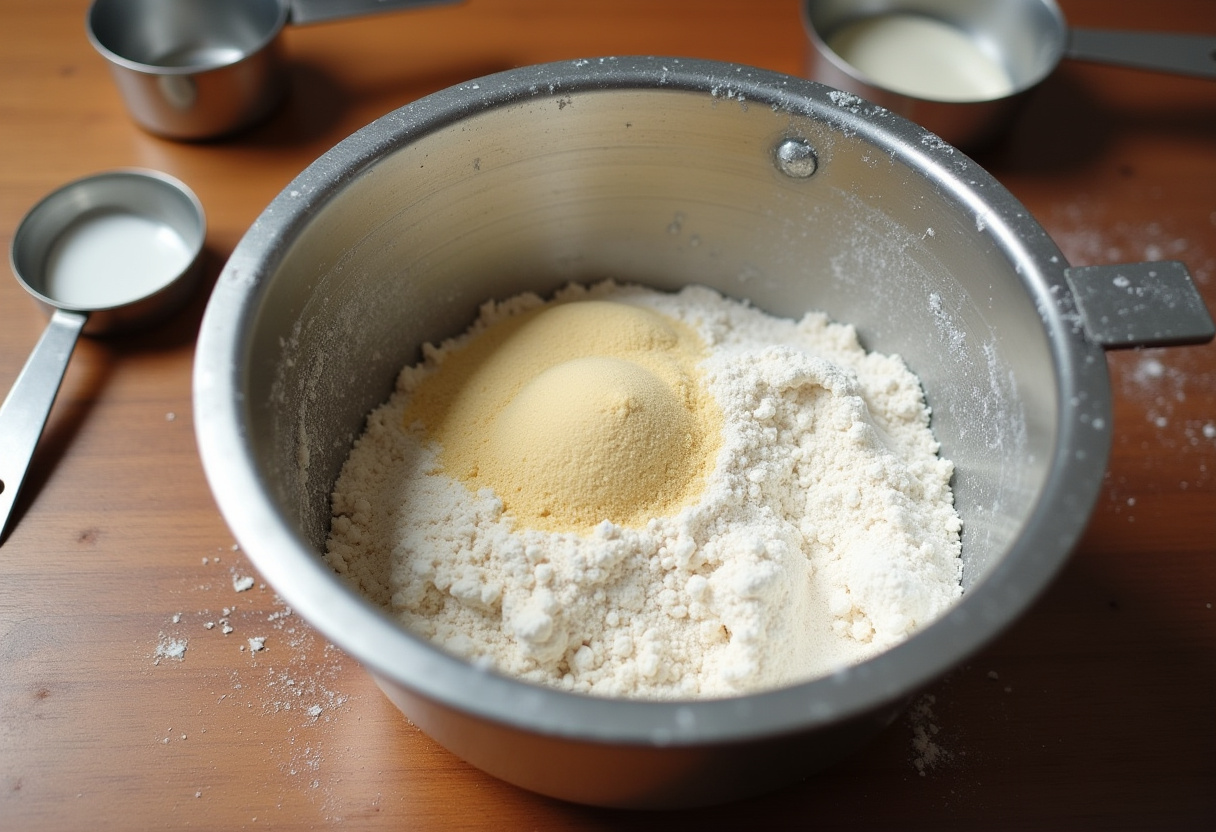
3. Step-by-Step Instructions
Step 1: Prepare the Dough
Begin by activating your yeast – this crucial step ensures your bread will rise properly. In a large mixing bowl or the bowl of your stand mixer fitted with the dough hook, combine the warm milk (test the temperature on your wrist – it should feel comfortably warm), sugar, and yeast. Let this mixture sit for 5-10 minutes until it becomes foamy and fragrant. This foam indicates your yeast is alive and active.
Add the melted butter (cooled slightly so it doesn’t cook the eggs), eggs, vanilla extract, and citrus zest if using. The zest adds a wonderful brightness to the bread – orange zest gives a sweeter note while lemon provides a more pronounced tang. Gradually mix in the flour and salt until a shaggy dough forms. Then knead for 8-10 minutes until the dough becomes smooth, elastic, and slightly tacky but not sticky. If you’re kneading by hand, use the heel of your hand to push the dough away from you, then fold it back over itself.
For those who love experimenting with doughs, you might enjoy the techniques used in our Mexican Mac and Cheese recipe which also involves creating the perfect texture.
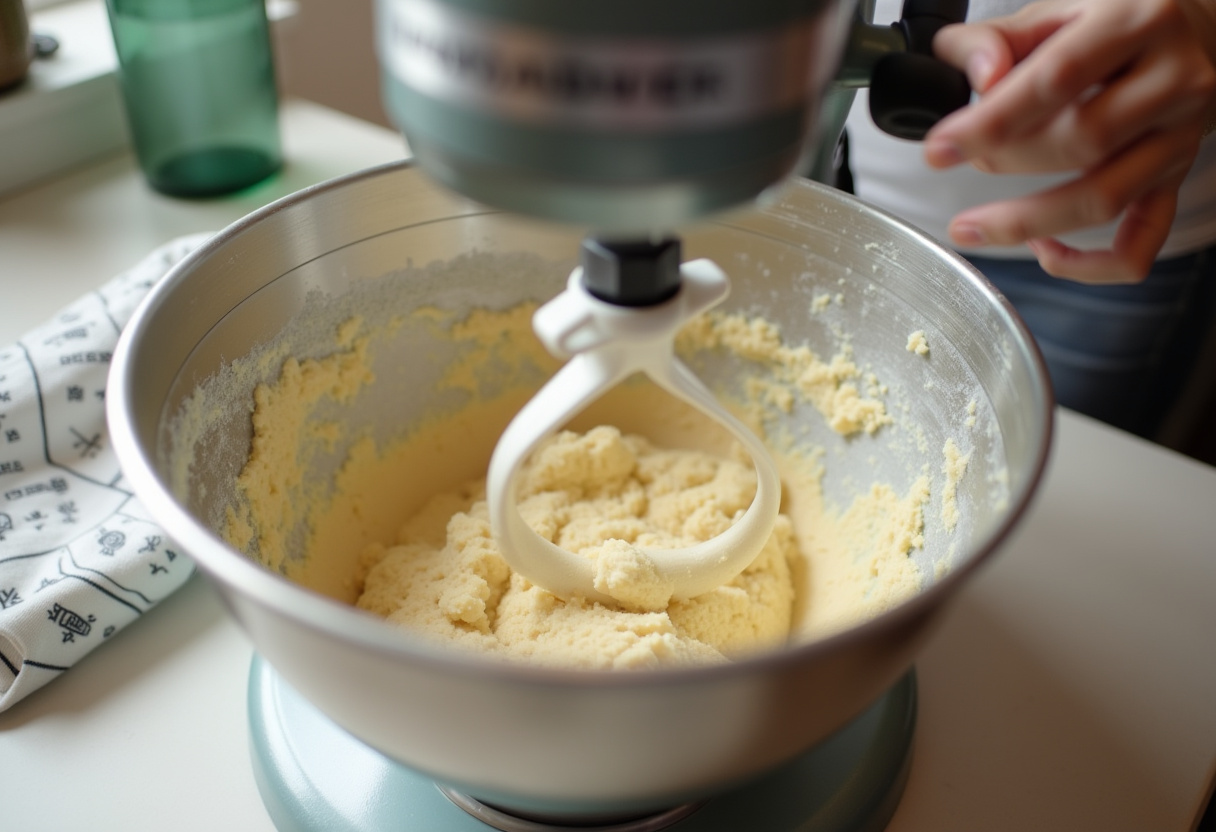
Step 2: Let the Dough Rise
Place the kneaded dough in a lightly greased bowl (you can use butter or neutral oil), turning it once to coat all sides. This prevents a skin from forming on the dough as it rises. Cover the bowl with a clean, damp kitchen towel or plastic wrap. Find a warm, draft-free spot for it to rise. Ideal places include:
- An oven with just the light on
- Near a radiator (but not touching)
- On top of the refrigerator
The dough should double in size, which typically takes 1-2 hours depending on the temperature of your kitchen. To test if it’s ready, gently poke the dough with your finger – if the indentation remains, it’s perfectly proofed. This slow fermentation develops flavor and creates that wonderful airy texture we love in Easter bread.

Step 3: Shape the Bread
Once risen, gently punch down the dough to release the air bubbles. Turn it out onto a lightly floured surface. Divide the dough into three equal portions using a bench scraper or sharp knife. Weighing the pieces ensures even braiding. Roll each portion into a long rope about 18 inches long. If the dough resists rolling, let it rest for 5 minutes to relax the gluten.
To braid, place the three ropes parallel to each other. Pinch the tops together tightly, then cross the right rope over the middle, then the left rope over the new middle. Continue this pattern, keeping slight tension on the ropes, until you reach the end. Pinch the bottoms together and tuck both ends under for a neat finish. Transfer the braid carefully to a parchment-lined baking sheet.
For more creative shaping ideas, take inspiration from our Copycat Chicken Bryan presentation techniques.
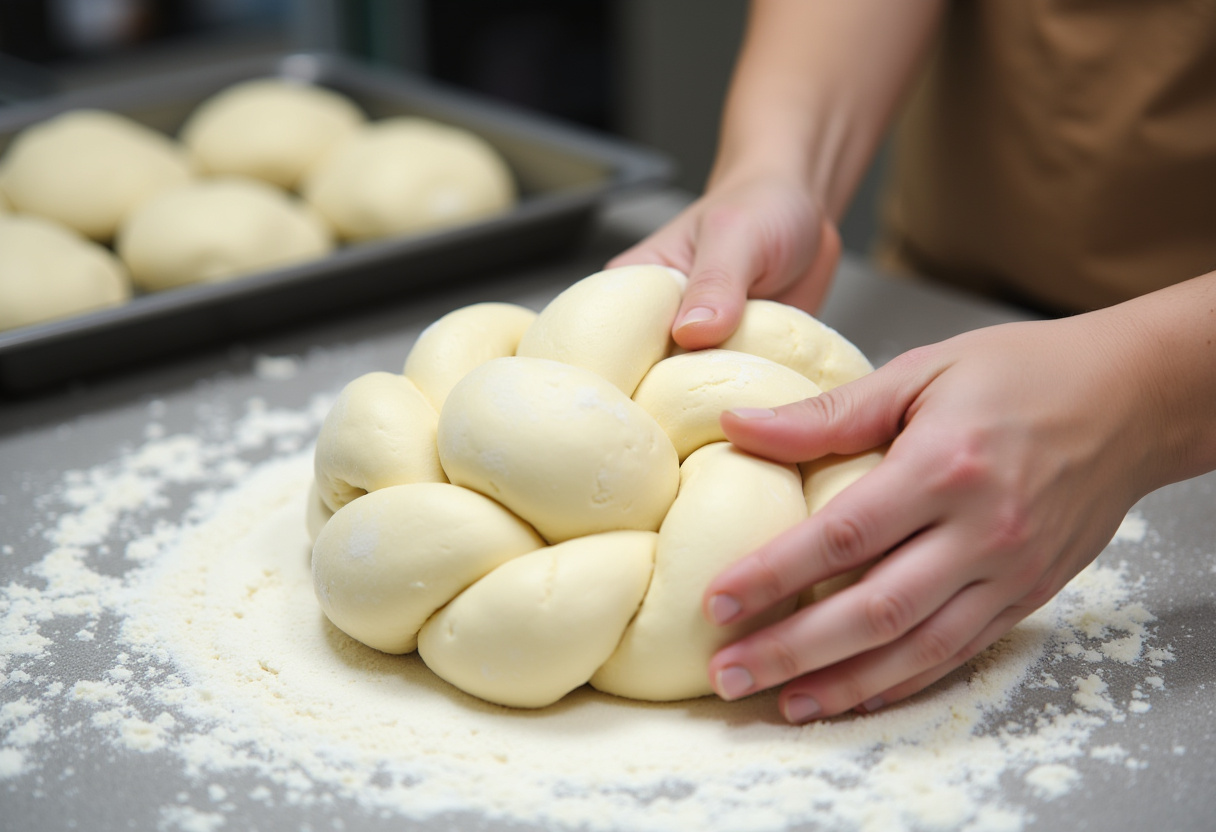
Step 4: Bake and Decorate
Preheat your oven to 350°F (175°C) about 20 minutes before baking. For an extra glossy finish, make an egg wash by beating 1 egg yolk with 1 tablespoon of water or milk. Using a pastry brush, gently apply this wash all over the braided loaf, being careful not to deflate it. Immediately sprinkle with colored sugar or nonpareils – the egg wash acts as “glue” for the decorations.
Bake in the center of the oven for 25-30 minutes until deeply golden brown. The bread should sound hollow when tapped on the bottom. If it’s browning too quickly, tent with aluminum foil. Let cool completely on a wire rack before slicing – we know it’s tempting, but cutting too soon will make the bread gummy!
4. Tips for Perfect Braided Easter Bread
- Yeast Quality: Always check the expiration date on your yeast. For best results, store yeast in the refrigerator or freezer.
- Temperature Matters: Ingredients at room temperature incorporate better. Take eggs out about 30 minutes before using.
- Kneading Technique: The windowpane test is the best way to check if your dough is kneaded enough – take a small piece and stretch it gently. If you can see light through it without tearing, it’s ready.
- Rising Environment: If your kitchen is cool, create a warm spot by placing the bowl of dough in the oven with a pan of hot water on the rack below.
- Even Baking: Rotate your baking sheet halfway through baking for even color.
5. Variations
While traditional Braided Easter Bread is delicious on its own, don’t be afraid to get creative with these variations:
- Chocolate Chip: Fold in 1/2 cup mini chocolate chips during the last minute of kneading. The small size distributes better than regular chips.
- Almond: Add 1/2 tsp almond extract to the dough and sprinkle with sliced almonds before baking for a marzipan-like flavor.
- Cinnamon Swirl: Roll out each rope into a rectangle, brush with melted butter, and sprinkle with a mixture of 1/4 cup sugar and 1 tbsp cinnamon before rolling up and braiding.
- Cream Cheese Filling: Spread a layer of sweetened cream cheese between the braids before baking.
- Savory Version: Reduce sugar to 2 tbsp, omit vanilla, and add herbs like rosemary or thyme for an unexpected twist.
For more creative recipe ideas, check out our Limoncello Spritz for another festive drink pairing.
6. Serving Suggestions
Braided Easter Bread is incredibly versatile in how you can serve it:
- Breakfast Centerpiece: Serve warm with softened butter and homemade jam. Pair with fresh fruit and coffee for a complete Easter morning spread.
- Dessert Option: Slice and serve with a dollop of whipped cream and fresh berries for a simple yet impressive dessert.
- French Toast: Stale bread makes incredible French toast – dip thick slices in an egg mixture and cook until golden.
- Bread Pudding: Cube leftover bread and use it in a rich custard-based bread pudding.
- Gift Idea: Wrap cooled loaves in cellophane with a pretty ribbon for a heartfelt homemade gift.
This bread pairs beautifully with many of our holiday dinner recipes for a complete Easter meal.
7. Storage Instructions
Proper storage ensures your Braided Easter Bread stays fresh:
- Room Temperature: Store in an airtight container or tightly wrapped in plastic for up to 3 days. The crust will soften but the flavor remains excellent.
- Freezing: For longer storage, wrap cooled bread tightly in plastic wrap then aluminum foil. Freeze for up to 1 month. Thaw at room temperature, then refresh in a 300°F oven for 5 minutes if desired.
- Reviving Stale Bread: Lightly mist with water and warm in a 325°F oven for 5-10 minutes to restore freshness.
8. Frequently Asked Questions
Q: Can I make this bread ahead of time?
A: Absolutely! You have two great options: 1) Prepare the dough the night before, let it do its first rise in the refrigerator overnight (this slow fermentation enhances flavor), then shape and bake the next day. 2) Bake completely, let cool, then freeze. Thaw and refresh in the oven before serving.
Q: Can I use instant yeast instead of active dry yeast?
A: Yes, you can substitute instant yeast 1:1. The main difference is you can mix instant yeast directly with the dry ingredients – no proofing needed. The rising times may be slightly shorter with instant yeast.
Q: Why is my bread dense?
A: Several factors can cause dense bread: old yeast that didn’t activate properly, dough that didn’t rise long enough, over-kneading which made the gluten too tight, or opening the oven door too early in baking causing the loaf to collapse. Ensure your yeast is fresh and give the dough ample time to rise.
Q: Can I make this dairy-free?
A: Yes! Substitute the milk with almond or oat milk, and use vegan butter or coconut oil instead of butter. The texture might be slightly different but still delicious.
Q: How do I know when the bread is fully baked?
A: The crust should be deep golden brown, and the internal temperature should register 190°F on an instant-read thermometer. If you don’t have a thermometer, the bread should sound hollow when tapped on the bottom.
9. Conclusion
This Braided Easter Bread recipe is more than just instructions – it’s an invitation to create lasting holiday memories. The process of mixing, kneading, and shaping the dough connects us to generations of bakers who have celebrated spring’s renewal with this symbolic bread. As you pull the golden loaf from your oven, take pride in continuing this beautiful tradition.
We hope this recipe becomes a cherished part of your Easter celebrations for years to come. For more holiday inspiration, explore our About Me page to learn about our culinary journey, or review our Disclaimer and Terms and Conditions for using our recipes.
If you’d like to explore another version of this classic, we recommend checking out this alternative Braided Easter Bread recipe for additional inspiration.
From our kitchen to yours, we wish you a joyful Easter filled with delicious food, loving company, and the warmth of tradition. Happy baking! 🐰🥚✨
Print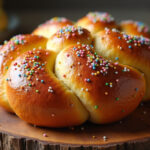
Braided Easter Bread
- Total Time: 3 hours
Description
Braided Easter Bread is a traditional, sweet, and beautifully decorated bread that brings joy to every Easter celebration. This recipe combines soft, fluffy dough with a hint of citrus and vanilla, making it a perfect centerpiece for your holiday table.
Ingredients
- 4 cups all-purpose flour
- 1/2 cup granulated sugar
- 1 packet (2 1/4 tsp) active dry yeast
- 1/2 tsp salt
- 1/2 cup warm milk (110°F)
- 1/4 cup unsalted butter, melted
- 2 large eggs
- 1 tsp vanilla extract
- Zest of 1 orange or lemon (optional)
- 1 egg yolk (for egg wash)
- Colored sprinkles or pearl sugar (for decoration)
Instructions
- In a large mixing bowl or stand mixer, combine the warm milk, sugar, and yeast. Let it sit for 5-10 minutes until foamy.
- Add the melted butter, eggs, vanilla extract, and citrus zest (if using). Gradually mix in the flour and salt until a soft dough forms.
- Knead for 8-10 minutes until smooth and elastic.
- Place the dough in a greased bowl, cover with a damp towel, and let it rise in a warm place for 1-2 hours or until doubled in size.
- Punch down the risen dough and divide it into three equal parts. Roll each part into a long rope (about 18 inches).
- Braid the ropes together, tucking the ends under. Place the braided loaf on a parchment-lined baking sheet.
- Preheat the oven to 350°F (175°C). Brush the loaf with egg yolk and sprinkle with colored sugar or sprinkles.
- Bake for 25-30 minutes until golden brown. Let it cool before serving.
Notes
- Use fresh yeast for the best rise.
- If the dough is too sticky, add a little more flour.
- For extra flavor, add raisins or dried fruit to the dough.
- Let the bread cool completely before slicing to avoid a gummy texture.
- Prep Time: 2 hours 30 minutes
- Cook Time: 30 minutes
Nutrition
- Serving Size: 1 slice (1/12 of loaf)
- Calories: 220 Kcal
- Sugar: 10g
- Sodium: 120mg
- Fat: 6g
- Saturated Fat: 3g
- Unsaturated Fat: 2g
- Trans Fat: 0g
- Carbohydrates: 36g
- Fiber: 1g
- Protein: 5g
- Cholesterol: 45mg
Keywords: Braided Easter Bread, Easter bread recipe, sweet bread, holiday baking, festive bread





No comment